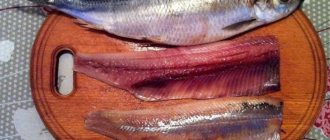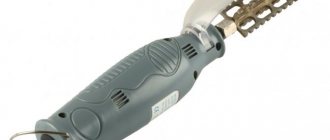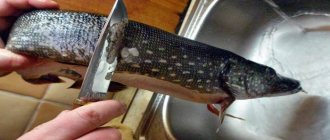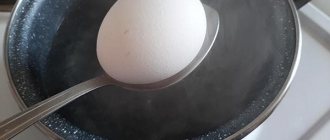Ways to properly and quickly fillet herring without bones or skin.
Most modern housewives prefer to buy ready-made herring fillets and use it for preparing appetizers and savory salads. But as practice shows, it is precisely this type of filleted fish that is often of low quality.
For this reason, it will be better if you buy whole herring and remove the skin, fins and bones yourself. In this case, you will be able to more correctly assess the freshness and quality of the product, thanks to which you will definitely be able to prepare a delicious snack from it. We will talk about how to clean herring without unnecessary problems in our article.
How to properly, easily and quickly peel herring: advice from chefs and housewives
Cleaning herring: advice from chefs and housewives
If you think that cleaning herring yourself is very difficult, then you are deeply mistaken. If you show a little patience, you can quickly get high-quality fillets. All that is required of you for this is to prepare a cutting board, a sharp knife and a few paper towels.
Simple tips:
- Take a cutting board and wrap it in plastic wrap or just put a few regular bags over it. This is necessary so that after filleting the fish your board remains clean.
- Prepare a knife with a thin blade. If you realize that it has become a little dull, then be sure to sharpen it. If you don’t do this, you will end up tearing the fish fibers when cutting and this will not allow you to make a perfect fillet.
- Be sure to have tweezers handy. You will use this to remove the thinnest and smallest bones from the fillet, located as close as possible to the herring ridge.
- Also place several paper napkins and towels on the table on which you will cut the fish. You will need them to remove blood and intestinal films from the fillet.
- It will be more convenient to peel the herring with your hands. In order to do this quickly, you will need to pry the skin in the area of the tail or head, and then gently pull it towards you. Be careful not to overdo the tension because the skin will tear and you will have to start the process all over again from the beginning.
What kind of fish is this and how is it useful?
The herring fish family is numerous, although only certain species are of commercial importance. Pacific and Atlantic herring are supplied to the shelves of Russian stores; after a long break, medium-sized iwasi has reappeared. In addition to them, you can often find Norwegian herring, as well as sprat and herring.
The peculiarity of herring is that it is an oily fish. In terms of healthy fat content, it is equal to expensive varieties of salmon, but costs several times less. Fish oil contains a large amount of unsaturated acids (omega-3, omega-6, etc.) and is considered beneficial for the cardiovascular system.
In addition to unsaturated acids, fat is a source of vitamin D, which is especially lacking in winter. The intake of vitamin D into the body is important for children and pregnant women, because it is involved in calcium metabolism and contributes to the proper formation of the skeleton and teeth, and the normal functioning of the kidneys. Sea fish also contains microelements valuable for the body: potassium, magnesium, iodine, selenium, etc. In terms of protein content, herring meat is comparable to beef, but is digested more easily and completely.
Herring is not good for everyone. If there are restrictions on eating fatty foods, then any dishes made from fresh, salted or smoked fish should be excluded from the diet. The calorie content of herring depends on the time of catch and type, but on average it is about 200 kcal/100 g.
Which herring to choose?
When buying fresh herring, pay attention to its gills: they should be dark red, without plaque or mucus. The eyes of the fish are bulging, clean and transparent. By pressing on the side of a fresh herring, you can feel the elasticity of its muscles. There should be no depressed area left on the carcass from pressing. The smell is pleasant, fishy.
Fresh frozen herring of good quality is evenly covered with scales, there are no yellowish spots or streaks on its sides. After rubbing it with your finger, smell it: the smell should be weak and pleasant, characteristic of sea fish. If the herring is covered with lumps of bloody ice and smells unpleasant, then it has already been thawed several times and it may be spoiled.
Salted herring is chosen based on the color of its eyes: a good lightly salted fish has red and convex eyes. Over-salted fish have a dull blue tint to their eyes. If the fish is vacuum-packed, the brine should be clear and red-orange in color. Cloudy liquid indicates spoilage of the product. It is undesirable to buy fish with damaged skin or belly, with yellow-rusty spots on the skin, because it has an unpleasant rancid smell.
How to quickly and correctly peel salted herring for slicing: photo
If your goal is a perfect fillet for slicing, then you need to clean the fish in the classic way and, if possible, do everything as carefully as possible.
So:
- Initially, you will need to rinse the herring and blot its surface with a paper napkin. This must be done so that it does not slide on the surface of the cutting board.
- When you are done with this stage, you can take the knife and proceed directly to cleaning the fish. To do this, place it on a board and cut off the head with a sharp knife. Next, make a neat cut along the ridge line and remove the upper fins in one motion. The lower fins can be cut off with ordinary kitchen scissors.
- The next step is to cut the belly of the herring. If you love the caviar and milt of this fish, then try not to insert the knife very deep. Carefully pull apart the belly and gut all the insides. Also, do not forget to immediately remove all films with a paper napkin.
- Use a knife to pry the skin in the scalp area and begin to remove it with a smooth movement. After the skin is removed, inspect the fish again and, if necessary, remove newly appeared dirt.
- Next, use your fingers to press down on the cut made along the ridge and begin to carefully remove one half of the fillet from the bones. Set the separated fillet aside and do the same manipulation with the remaining part.
- After the ridge is removed, you will need to arm yourself with tweezers and try to remove all the small bones as thoroughly as possible. The finished fillet will need to be cooled and only after that can it be cut into portioned pieces and served on the festive table.
Classic method
- First of all, cut off the head, fins and make a longitudinal cut on the belly / Photo: obaldela.ru
- Take the herring, make a cut near the head with a sharp knife and cut the ridge. Next, pull the fish head towards you to separate it from the carcass and grab the insides. Open the belly, remove the black film from the walls with a knife and the insides, if any remain. Trim the fins and tail.
- Next, cut along the ridge, lift the skin and remove it from the meat. Feel the ridge through the abdomen and first separate one half, and then the other. Now inspect the parts of the carcass to see if there are any small bones left in them. They can be removed by hand or taken out with special tweezers.
If you are preparing “Shuba”, we recommend cutting the herring this way.
How to clean salted herring from bones on fillets for salad, fur coats: step by step with photos?
Step-by-step photo of cleaning herring
If you plan to use herring fillets to prepare a salad, then you can use the so-called pressing method for this. This method differs from the previous one in that you first have to get rid of the backbone of the fish and only then remove the skin from it.
So:
- To begin, prepare a cutting board, a sharp knife, paper napkins and tweezers. When everything you need is laid out on the table, rinse the herring under running water and dry thoroughly.
- Take a knife in your hands and cut off the head, tail and fins of the fish as carefully as possible. Cut open its belly and take out all the insides. If you see that there are a lot of films or remains of offal left inside the belly, be sure to rinse the fish under water again, and then dry everything with paper napkins.
- Wrap the fish prepared in this way in cling film and tap it on the table or lightly beat it. This little trick will help ensure that even small bones can be easily separated from the fillet.
- Place the track belly down and, pressing lightly on it, open it like a book. Press it down onto the table, then turn it over and gently remove the spine.
- At the final stage, divide the workpiece into two separate fillets, remove the skin from them and remove all the bones using tweezers.
Useful tips
In addition to the basic methods of cleaning your favorite product, there are several simple techniques. Their use will make the cutting process as efficient and convenient as possible:
- Before starting work, you need to make sure that the knife is sharp enough. A blunt instrument can damage the fibers and ruin the appearance of the fillet.
- To prevent your hands from absorbing the herring aroma, it is better to work with rubber, polyethylene, vinyl or latex gloves. It is also advisable to wear an apron to avoid staining your clothes and cover the work surface with paper or cling film.
- You need to use a separate cutting board for fish. To prevent the surface from absorbing an unpleasant odor, you can cover it with white paper or wrap it in cling film. At the end of cutting, the waste material must be removed, the offal and bones wrapped in it, and then discarded. The surface will remain almost unstained.
- To clean the board after cleaning the fish, you need to wipe it with a sponge and detergent and rinse well under running water. If the smell still remains, treating your hands and board with lemon juice will help eliminate it.
- To make the herring easier to clean, you should dip it in hot water or keep it in cold water with the addition of a few drops of vinegar.
- You can remove excess salt from overly salted herring by soaking the fillet in strong tea.
- A very successful brine for barrel herring is 0.5 liters of water, 1 tbsp. l. sugar and 1 tbsp. l. salt. Fish soaked for 24 hours in such a marinade will be lightly salted. To increase the degree of salting, you need to leave it for another 2-3 days.
- To improve the taste of fish, use pickled onions, soaked for 2-3 hours in water with a small amount of vinegar (or citric acid) and sugar.
- If you do not plan to use the fillet immediately after cutting, it is better to wrap it in cling film and put it in the refrigerator.
- Herring prepared from scratch turns out delicious. To do this, you should buy fresh fish, cut it into portions, put it in a jar and fill it with water, to which vinegar, mayonnaise and onion have been added. After 12 hours, the herring becomes tender and its bones become soft.
Herring is tasty, healthy and popular in the domestic kitchen as an independent snack or a key ingredient in mincemeat, “fur coat”, fish rolls, herring caviar, etc. You should not be afraid of the process of cutting this fish. Knowing the basic techniques, even an inexperienced cook can cope with this task.
How do you like the article?
How to debone herring fillet in one motion
Cutting herring in one motion
Those who want to clean the herring from the bones in one motion can use the method that we will introduce you to a little below. But remember, in order to get exactly the result that you expect, you must hold the fish’s tail very tightly.
In view of this, if you feel that it is starting to slip out, then simply cover each part of it with a paper towel and then fillet the fish.
Recommendations for deboning herring in one motion:
- At the initial stage, it is necessary to carry out standard preparation of the carcass for cutting. This means you must gut it and remove the fins. At this stage, you can additionally dry the abdomen and remove any remaining intestinal films from it.
- Make a cut on the tail of the herring no more than one centimeter deep, and then take it in your hands and begin to make somersault movements towards yourself. If you do everything correctly, the herring will describe circles around its tail.
- In the next step, you must tear the fish into two parts in one sharp movement. As a result, you should be left with two boneless bellies and a loin with a ridge. It can be easily separated from the fillet by hand.
- At the very end, all you have to do is remove the remaining small bones and you can cut the herring for a salad or snack.
How long to cook cabbage leaves for cabbage rolls
It is advisable to observe the cooking time, especially when keeping cabbage leaves in boiling water. It depends on the type of cabbage. There is no exact number, only approximate ones:
- early varieties of small size - no more than 10 minutes;
- elastic head of late variety cabbage – up to 25 minutes;
- leaves – about 4 minutes;
- young and soft cabbage (Peking cabbage) - just pour boiling water over it.
During storage, the product is more dense, which makes the process more difficult. It is necessary to boil the head of cabbage without the core separately and in several stages. After 20 minutes, you can remove the top leaves of the cabbage, only the soft ones. The rest of the fork needs to be cooked for about 15 minutes.
How to quickly and correctly clean fresh herring from bones and fillet: photo
Cleaning fresh filleted herring
As you already understand, if desired, the herring can be very quickly cleaned of skin and bones. If you want to simplify this process as much as possible, then use the method described below.
In this case, you can get a beautiful boneless fillet in literally a matter of minutes. True, you must remember that it is easiest to clean the largest herring using this method.
So:
- Take fresh herring, gut it and remove intestinal membranes.
- Use kitchen scissors to remove the fins, and then use a knife to make a longitudinal cut along the ridge line
- Next, stick your finger inside the fish and begin to carefully separate the fillet
- Separate one half, set it aside and use the same movements to remove the bones from the other fillet.
- Inspect the herring and, if necessary, remove small bones with tweezers
Why is it better to peel the herring yourself?
Before making a choice between buying a whole carcass or a cut fillet, most housewives will choose the second option. For example, if for the salad “herring under a fur coat” you need pitted herring, you don’t want to bother with it for a long time. TO
Of course, this option is not bad, but if you want to prepare tasty and high-quality dishes, it is better to first find out the reasons why it is better to buy a whole fish and clean it yourself:
- You can check the freshness of a whole carcass by simply looking into its eyes.
- But unscrupulous producers often make fillets from spoiled fish.
- Small seeds are often removed using chemical compounds, causing them to simply dissolve.
- Buying whole herring will be cheaper.
How to get rid of small bones in herring?
Removing small bones from herring
A large number of people refuse to eat herring due to the presence of small bones in it. But if you don’t buy ready-made fillets, but try to make them yourself, you can easily get rid of the bones. If you fillet pickled or salted herring, then you will need to arm yourself with ordinary tweezers and gradually remove all the bones from the fibers.
But keep in mind that in the ridge area the bones are located quite deep and for this reason they sometimes cannot be seen with the eyes. In view of this, it will be better if you first remove all visible bones, and then begin to carefully probe the fillet with your fingertips and remove whatever you find. This procedure should be completed only after your fingers stop finding the bones. If you remove bones from frozen fish, you will first need to peel and fillet it, and then literally put it in lightly salted water for 15 minutes.
After this time, the fish will need to be removed from the brine, rinsed, and then easily removed all the bones using tweezers. And finally, we want to tell you about a radical, but very fast method of removing small bones. In order to get rid of them in one movement, you will need to take and carefully draw a longitudinal line along the top of the fillet with a knife (its width should be approximately 5 mm). By doing this, you will immediately remove all the bones and you will not have to waste time searching for them with your hands and removing them with tweezers.
Preparation of the workplace
In order to quickly clean the herring and not stain everything around it with fat, which has a strong and unpleasant odor for many, you need to prepare in advance everything you need for work. Inexperienced housewives can cover part of the table with plastic wrap to reduce their time cleaning after work. The set of tools and related materials is small and includes simple kitchen utensils.
Cutting board
It is better to have a separate board for cleaning fish: even after thorough washing, it can retain a characteristic odor. It is better to choose plastic products. They do not absorb fat, are easy to clean with any dishwashing detergent and are not damaged by sharp knives. After each cutting of herring, the wooden board will have to be scraped and washed thoroughly.
The most convenient board is one on which the whole carcass fits. This will make the table less dirty. It is advisable to buy a board with a groove along the contour: when cleaning and cutting salted herring, the brine remaining on the carcasses will not roll off it.
Knife and tweezers
These tools will be needed to fillet the fish and remove any remaining small bones. Tweezers are not necessary, because if you carefully remove the fillet, there will be almost no bones left in it. You can remove them using the same knife that was used to cut the herring. But the presence of tweezers makes the work more convenient.
Hand and clothing protection
It is best to wear gloves with a rough surface (rubber, polyethylene) on your hands. They will not only protect your hands from the persistent aroma of fish, but will also help avoid injury to the skin from small sharp bones. In addition to gloves, prepare paper towels or napkins to wipe your hands or knife, remove drops of brine from the table, etc.
To protect your dress from accidental splashes, you should wear an apron that covers both the hem and chest. Sleeves can be rolled up to the elbows.
Which herring to buy: fillet or cut it yourself?
Recommendations for choosing herring
If you want to make your own herring fillet, then you need to choose the right fish for this. If you decide to save money and buy low-quality herring, then it is unlikely to produce a perfect fillet. Therefore, when choosing this product at the market, store or supermarket, first of all pay attention to its smell.
You don't even have to pick it up to do this. You can simply get as close as possible to the counter where the herring is lying and take a deep breath. If it is spoiled, you will feel a rather specific and unpleasant smell that will smell like rot. Fresh and properly stored herring will have a distinct marine smell. Once you are sure that the fish smells right, try to feel it, paying special attention to the belly.
If you feel that it is too soft, then most likely you have a stale product that has been defrosted many times. Also be sure to look at the color of the herring’s gills. If they are dark red and elastic, then you can safely make a purchase. And finally, look at the eyes. If they are cloudy, this indicates that the seller is offering you a completely damaged product.
Preparation for cutting
Experts recommend buying whole, uncut herring. This way you can easily check its quality. Usually pay attention to the gills and eyes.
- The color of the gills should be dark red. A darker color indicates that the herring is no longer fresh and unsuitable for food. Another sign of freshness is that the gills are elastic and do not fall apart.
- The fish's eyes should not be cloudy or protruding from their sockets.
Also pay attention to the smell. There should not be any foreign impurities in it (for example, bitterness or rottenness). To avoid mistakes, buy only fresh or lightly salted herring. The more spicy the salt, the more likely it is that the manufacturer used it to hide unpleasant odors.
There should be no stains, cuts or holes on the covers of high-quality fresh or lightly salted herring. After the integrity of the skin is damaged, oxidative processes occur inside the carcass, invisible from the outside, and the fish begins to quickly deteriorate.
It is better to buy whole herring carcasses to control its quality
So, the herring has been purchased, and you need to start cutting it. For this you will need:
- cutting board;
- sharp knife;
- tweezers or tweezers for removing small bones;
- plastic bags for waste.
It will be better if you have a separate board for cutting fresh or lightly salted herring. The fact is that this fish has a persistent and corrosive odor that is difficult to wash out of a wooden surface. You can place a sheet of cardboard, paper, or a thick napkin on the board (this makes it even more convenient to remove waste). But under no circumstances should you spread the newspaper! Printing ink will definitely end up in your stomach along with the herring, and this is harmful to the body.
It is also advisable to have a separate knife. It’s good if you have a set of knives, including a special cutting knife for fish.
If you have long nails, you can easily remove small bones from a cut carcass. Otherwise, arm yourself with tweezers or eyebrow tweezers.
How to cut herring at a factory: video
Above, we have already introduced you to simple homemade methods for turning a herring carcass into a perfect fillet. And as you probably already understood, this task is within the power of any person, even those who have never cooked anything in their life.
But finally, we decided to show you that fillet made on an industrial scale can also be of high quality and tasty. To do this, we bring to your attention a video from which you will learn how this delicious fish is cut in large production facilities.
How to separate cabbage leaves for cabbage rolls
It is better to remove cabbage leaves separately without damage from a medium-sized head of cabbage (more accessible). The stalk must first be removed. Pour water into the resulting hole to the edge; you can keep it under running water or in a container with water until it gets wet. Remove the soft leaves by hand, this way they will all come off gradually.
How to beautifully serve herring on the table: photo
Submission idea #1
Submission idea #2
Submission idea #3
Submission idea #4
Submission idea #5
How to cook cabbage leaves for cabbage rolls
The cabbage head can be cooked whole or the leaves can be boiled separately. For the first method you need to prepare in advance:
- Remove the weak first cabbage leaves from the head.
- Use a knife to remove the stalk, preventing them from sticking together in the final result.
- Pour cold water into a container of sufficient size, place forks in it, and cook until the leaves are soft.
The second method involves cooking the leaves separately (you must first remove them from the head of cabbage). Cook in the same way as the first method, just add salt and vinegar to the water (to prevent cracks and third-party damage).
LiveInternetLiveInternet
Many of us love cabbage rolls very much, but have absolutely no time to cook them. And sometimes you really want real, homemade ones with sour cream. To avoid spending a lot of time and effort and prepare a delicious treat, use this simple trick.
Previously, you had to boil a head of cabbage, wait a long time for it to boil and cool, but now everything has become much easier.
Method No. 1
To start, choose the right cabbage. The head of cabbage should be slightly flattened so that the leaves are large and thin.
Wash the cabbage, remove the top few leaves, remove the stalk and place the cabbage in the microwave. If it weighs 1.5–2 kg, then you need to set the mode to 900 W for approximately 12 minutes.
Once the time is up, remove the cabbage from the microwave and check the leaves for softness by simply pressing on them. Then place the head of cabbage under cold running tap water and slowly roll up the leaves.
Now you can cook cabbage rolls more often!
Source: kaifzona.ru
Method number 2
I read about your method of stripping a head of cabbage rolls and I’ll tell you frankly that it’s all very troublesome. In my family, cabbage rolls are also very welcome, and that’s why I make them often. There was always a problem with leaves, but one day, while standing in line at a store, I overheard two women talking about how to strip a head of cabbage. It turns out that everything ingenious is simple.
Take a head of cabbage and cut off almost 1/3 of it (where the stalk and thick parts of the leaves are located) with a sharp knife. Set this part aside for now. Boil water in a large saucepan, place the trimmed head of cabbage (2/3) in it and leave it to boil a little. After a while, take a fork and simply pick up the leaves, which come off very easily. I usually separate the leaves and do not immediately remove them from the water. Leave in slightly boiling water for 2-3 minutes. and pull it out. Everything is very fast. Moreover, the more you cut off the part with the stalk, the easier it is to separate the leaves, since when cutting, you seem to “cut” the junction of the cabbage leaf and the stalk.
P.S: I don’t throw away the reserved part, but chop it and place it between the cabbage rolls or simply grind it in a meat grinder along with the minced meat, which only gets juicier from this. I share this method with all my friends at home and at work. Believe me, there are no disappointments, but only surprise - how they didn’t think about it before.
Method number 3: Freezing
Just put the cabbage in the freezer for 12 hours. Then we take it out and defrost it. And the leaves come off the cabbage easily.
Source: vk.com
* * *
Cabbage for cabbage rolls - Without WATER! 3 Best Ways!
Stuffed cabbage rolls from Young Cabbage + NEW METHOD for twisting Mini Stuffed cabbage rolls
Stuffed cabbage rolls in a new way from Frozen Cabbage
BON APPETIT !!!
Your LYUBASHA BODIA
Basic Rules:
- When cleaning salted (smoked) fish, it is advisable to use a separate cutting board. Wood fibers quickly absorb fat and blood, which promotes the growth of bacteria. In addition, after the herring the smell of the board will be, to put it mildly, unappetizing. Plastic boards are less susceptible to diffusion, but still become unusable. Cling film and clean paper will help protect the board from fishy smell. Newspapers are not suitable for these purposes. I don’t know exactly what is added to printing ink, but there is clearly no benefit from its contact with food. After cleaning, roll up the paper along with the bones and giblets. The board will remain almost clean, no unpleasant smell, no greasy stains. Just rinse it with a drop of detergent.
- A sharp knife is the key to quickly cleaning herring and creating smooth, neat fillets.
- To get rid of a specific odor from your hands, pour lemon juice (diluted with table vinegar) on them. Washing in beer also helps (50-70 ml is enough). Grated potatoes, distributed over the surface of the palms and between the fingers, will also help eliminate the obsessive “aroma”.
- It is advisable to have a roll of thick paper napkins on hand to periodically wipe the knife and hands.
- It is convenient to remove small bones with special tweezers.
Fish
Stuffed cabbage rolls with minced cabbage leaves
Cooking meat cabbage rolls according to a special recipe gives the dish tenderness and juiciness. They complement the festive table and regular dinner.
First you need to prepare the necessary ingredients:
- cabbage – 2 kg (it is advisable to choose early young varieties);
- rice, preferably steamed – 200 g (with a little cheese);
- minced pork or beef – 0.5 kg;
- white onion – 2 medium heads;
- carrots – 1 large;
- thick tomato paste – 50 g;
- wheat flour – 50 g;
- salt, a mixture of peppers, garlic, suneli hops (any others are possible) - to taste;
- sour cream – 15% fat content;
- vegetable oil – 35 g;
- dried herbs (onion, dill, parsley) - optional.
The method of preparing the dish is easy and simple; you cannot deviate from the recipe (this will change the taste):
- Preliminary preparation of cabbage leaves: divide the head of cabbage into leaves and cut them (if necessary, medium-sized ones are needed), remove the core.
- Cook in boiled salted water for about 10 minutes, it is important that they soften well.
- Peel the onions and carrots. Cut the onion into cubes, grate the carrots finely. Season all this with oil and fry until golden brown.
- Prepare the filling: combine boiled rice, minced meat, half an onion, carrots and spices. Mix until smooth.
- Wrap the resulting meat mass in warm or cool cabbage leaves; the amount of filling is arbitrary (depending on the size of the leaf).
- Place the cabbage rolls in a cauldron or pan, pour warm/hot water into the container to the top, cook over low heat for about 40-50 minutes.
- Upon completion of the stewing process, drain excess water, add tomato paste, flour, carrot-onion mixture, mix thoroughly. Add the ingredients to the pan and simmer slowly for about 15 minutes.
- When serving, place sour cream next to it and sprinkle with herbs on top.
For tender cabbage rolls, it is important to prepare cabbage leaves. The recipe and filling may be different, you can experiment. If you follow all the steps, you get a simple and tasty hot dish.
How to get a great fillet
If “silver of the seas” was used only as one of the ingredients for the salad, then no questions would arise: “how to get whole pieces?” But the herring is cut into slices, sandwiches are made from it, and the fish simply must have a decent appearance.
But what to do with the seeds: as a rule, at the time of salting, the smallest ones dissolve on their own. Large ones are removed during cleaning, but medium ones have to be removed either with tweezers or with your hands. After all, a perfect fillet should not contain bones.
Sometimes it happens that the hostess, without calculating the number of guests, cleans more fish than may actually be useful. Remember that the herring cannot be left just like that. It is one of the quickly perishable products. And it is better to preserve excess fillet, for example, with sunflower oil or lemon juice. In a regular glass container, covering with a lid. Then you can treat yourself to fish in a couple of days.










